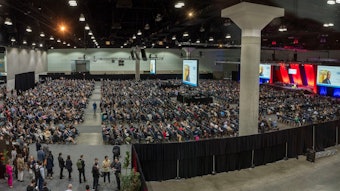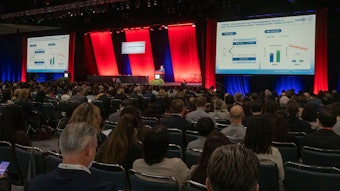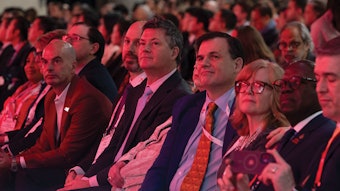2023 Late-Breaking Science: SPAN results, monitoring ischemic stroke in small- and large-vessel disease and positive neuroprotective effects from aptamer

Late-Breaking Science presented during the Wednesday Opening Main Event reported that:
- A novel preclinical model of ischemic stroke suggests uric acid improves functional outcomes.
- 20% of cardioembolic stroke survivors have atrial fibrillation.
- Aptamer trial shows neuroprotection after ischemic stroke.
A novel Stroke Preclinical Assessment Network (SPAN) identified potential neuroprotective effects from intravenous uric acid (UA) given with thrombolysis following acute ischemic stroke. Six independent laboratories performed a standard transient middle cerebral occlusion in equal numbers of males and females of young mice, young rats, aging mice, mice with diet-induced obesity, and rats with spontaneous hypertension. Following surgery, animals were given thrombolysis plus UA or five other promising neuroprotective candidates. UA exceeded a predetermined efficacy boundary while other treatments did not.
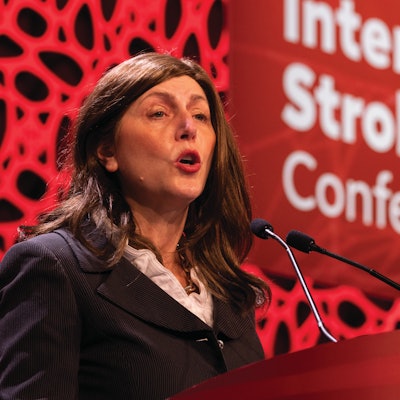 Lauren H. Sansing, MD, MS, FAHA
Lauren H. Sansing, MD, MS, FAHA
“Experimental rigor is something we can control,” she said.
SPAN was created to address the lack of experimental rigor impeding the translation of promising neuroprotective agents from animal models to clinical trials. The network linked six laboratories, a central coordinating center, and the National Institute of Neurological Disorders and Stroke (NINDS), using a clinical trial design to develop neuroprotective interventions, which can be rapidly moved from preclinical assessment into clinical trials.
Research centers included the University of Georgia, Augusta; Yale University, Massachusetts General Hospital; University of Iowa; University of Texas, Houston; and Johns Hopkins University. Interventions included fasudil, a rho-associated kinase (ROCK) inhibitor; remote ischemic conditioning; veliparib, a poly (ADP-Ribose) Polymerase (PARP) inhibitor; tocilizumab, an interleukin 6 receptor antibody; uric acid, a potent free radical scavenger; and fingolimod, a sphingosine 1-phosphate (S1P) analogue.
Researchers randomized 2,518 animals to treatment, control and sham surgical arms. All animals were treated with thrombolysis after surgically induced stroke, followed by one of six interventions or placebo. The primary outcome was a corner test at day 28. Treatment assignment was concealed from surgeons while all examiners and raters were blinded to treatment.
“SPAN demonstrated the highest possible rigor and phenomenal data quality, protocol adherence, throughput and timeline,” Dr. Sansing said. “Congratulations to the Iowa team that proposed uric acid, which we believe is appropriate for further investigation.”
Unsuspected AF common in stroke survivors
Three-year results of the STROKE-AF trial showed that 21.7% of patients with ischemic stroke attributed to small- or large-vessel disease with an insertable cardiac monitor (ICM) have atrial fibrillation (AF) detected over the following three years, a 10-fold increase in the incidence of AF detected by usual care. In the ICM arm, the median duration of the longest AF single episode was 10 minutes (and 37.2% of patients had a single episode ≥1 hour). The median maximum daily AF burden was 18 minutes.
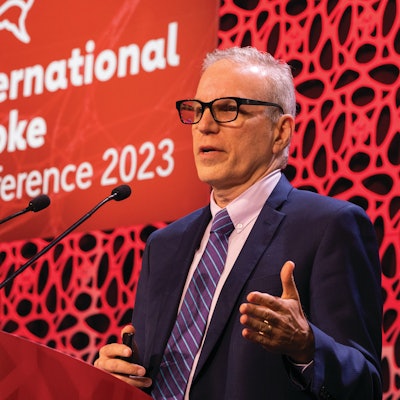 Lee H. Schwamm, MD
Lee H. Schwamm, MD
STROKE-AF randomized 492 patients with ischemic stroke attributed to large- or small-vessel disease to evaluation with an ICM or usual care. Patients were ≥60 years with a median CHA2DS2-VASc score of 5. Over the first year, 12.1% of patients in the ICM group had AF detected versus 1.8% of usual care patients. At three years, 21.7% of ICM patients had confirmed AF versus 2.4% in the usual care arm, a hazard ratio of 10.0 (95% CI 4.0-25.2, p<0.001).
About 70% of patients with AF detected were started on anticoagulation therapy. This trial was designed to detect AF and was not designed or powered to detect treatment differences or clinical outcomes. Because treatment strategies were not assigned or specified as part of the protocol, the reasons patients with AF were not given anticoagulation remain unknown, Dr. Schwamm said. Patients with large- or small-vessel disease stroke are typically not considered for AF detection, and there is limited evidence to guide management.
“The rate of unsuspected atrial fibrillation in this high-risk population is substantial,” Dr. Schwamm said. “If, upon learning that substantive AF was detected, you would prescribe anticoagulation for patients similar to those enrolled in the Stroke AF trial, then you should definitely insert a monitor for patients with a stroke attributed to small- or large-vessel disease. If you would not start anticoagulation in them regardless of what you found on continuous monitoring, then don’t insert a monitor. But if seeing an hour of AF is something you would act upon, you can’t afford to use standard of care approaches and patient self-report to exclude AF.
Aptamer trial shows neuroprotection after ischemic stroke
ApTOLL, a novel aptamer targeting toll-like receptor 4 (TLR4) showed positive neuroprotective effects and good safety in combination with endovascular treatment — with or without intravenous thrombolysis as needed — in an early phase clinical trial. In the phase 1B/IIA APRIL trial, patients allocated to placebo presented a mortality rate of 18.2% versus 4.8% mortality in patients allocated to 0.2mg/kg of ApTOLL, a statistically significant difference. The final infarct volume measured on MRI at 72 hours and the distribution in the range of disability measured by modified Rankin Scale (mRS) at 90 days also favored patients who received 0.2mg/kg of ApTOLL
 Marc Ribo, MD, PhD
Marc Ribo, MD, PhD
ApTOLL is a synthetic, single-strand DNA designed for high binding affinity to TLR4. The agent blocks downstream release of proinflammatory cytokines that are responsible for the initiation and progression of brain injury following ischemic stroke, said Dr. Macarena Hernandez, chief scientific officer at aptaTargets. APRIL phase IB compared safety in four ascending doses of ApTOLL in ischemic stroke patients with large vessel occlusion within 6 hours of onset at 16 European centers. Eligible patients had Alberta Stroke Program Early CT Score (ASPECTS) 5-10 and an estimated infarct core volume of 5-70 ml by CT-perfusion scan.
The data safety monitoring board selected two doses for phase IIA, 0.5 mg/kg and 0.2 mg/kg.
A total of 119 patients received 0.05mg/kg ApTOLL (36), 0.2mg/kg ApTOLL (36), or placebo (47). Both doses had similar safety profiles, Dr. Ribo said, but the higher dose had greater efficacy. Mortality at 90 days had a relative risk ratio of -0.13 for high-dose ApTOLL versus placebo. The higher dose also showed an odds ratio of 2.61 for better mRS score at 90 days versus placebo and a nonsignificant trend for reduced brain edema and hemorrhagic transformation.
“There does not seem to be any cross-reaction between ApTOLL and intravenous thrombolysis, which has been a problem in other trials of neuroprotective drugs,” Dr. Ribo said. “From what we have seen, ApTOLL and IV tPA work in parallel pathways and do not interact with each other.”
